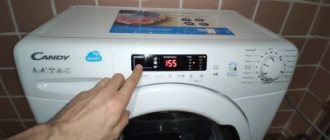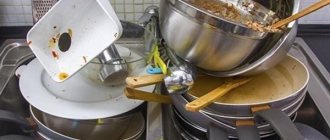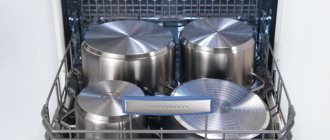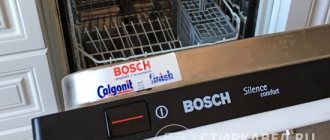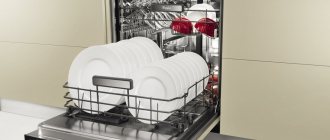A dishwasher, like any other electronic device, may have various problems associated not only with the device’s startup or operating process, but even with shutdown.
However, problems most often arise during work, and a separate issue that can be highlighted is the machine freezing during operation.
You can also find out why your dishwasher may not work by following the link.
Typical faults
Many problems in the operation of the dishwasher, if the situation worsens, result in serious malfunctions. Most of them are avoidable and preventable. It will be necessary to carry out not only regular maintenance, but also to fully comply with operating rules, safety precautions, as well as requirements for installing and configuring such equipment.
If all the conditions are met, but the machine still gives an error, then the issue may involve one of the characteristic malfunctions characteristic of dishwashers.
There are several typical situations:
- The machine does not turn on. First of all, you should check whether water and power are supplied to the machine. The circuit may have been broken due to a short circuit using the circuit breaker. You can also unplug the cord from the outlet for thirty seconds and plug it back in while turning on the dishwasher.
- The appearance of water under the machine. The reason for this phenomenon may be damage to the discharge or drain hose, exceeding the permissible water level, or a malfunction of the lower sprayer. Also, a simple misalignment when installing the machine can be the cause of a leak.
- The dishes were not washed well. This means that the holes in the sprinklers are clogged and require cleaning.
- The water does not heat up. It is possible that the heating element has burned out or the control board is malfunctioning.
- Loud noise during operation. This is a sign of improper installation of the machine or a consequence of wear on the pump.
- Dishes do not dry. Most likely, the dishes were stacked incorrectly and too close together.
The washing program is stuck
Various errors can occur during operation of the dishwasher, and the most common problem is the washing program freezing. As a result, the user may need to reload the dishwasher. Most errors have their own codes (for example, error code i30, e4, e03, e09 and others), the interpretation of which can be easily found in the manual, and brief information is displayed directly on the screen.
System failures are described in the control module program, this includes the program of the popular Bosch dishwasher. This allows self-diagnosis and alerts the user about various problems. Often the error that occurs does not disappear even if the device is rebooted or turned off and then on. The only solution to such a problem is to determine the cause and completely eliminate it.
The program freezing error can be caused by a variety of reasons. However, this often happens when the user does not perform regular cleaning and maintenance. As a result, the filters can become clogged, then the sensors are triggered, and the control module can block the operation of all machine components. This will continue until the blockage is completely cleared.
It happens that during operation a certain number of errors of various types accumulate. They are insignificant and do not interfere with operation, but after a certain time the machine may begin to malfunction or may not start on the first try, which can lead to serious breakdowns in the future.
Those who are wondering how to reset accumulated errors should press a certain combination of buttons and perform some actions.
First, the user opens the dishwasher door and turns on the device itself. Next, program buttons 1+3 are simultaneously pressed and held for three seconds, and then the door closes. Then the door opens again, and the dishwasher is turned off from the network, then turned on again. Now press and hold the reset button for three seconds. The door closes again and the user waits for the signal to finish washing. After receiving the signal, the door opens and the machine turns off.
Water saving level in dishwashers
Both the selected washing mode and the PMM model determine how much water it will consume. On average, this is from 10 to 13 liters per procedure as a whole. Unlike manual washing, all water is used only for its intended purpose without any loss.
During the process, the working fluid is cleaned using special filters and is supplied completely renewed for rinsing. Economy modes reduce the amount of water consumed by 25%.
The profitability of PMM is indicated by symbols. Highly economical units are marked with the letters A, B, C. They consume 9 - 16 liters. Average-economical dishwashers are designated in the form of the letters D, E. They consume slightly more water - up to 20 liters. Low-efficiency machines with the letters F, G require 26 liters per cycle.
Reason #2: filter clogged
You, of course, do not forget to remove food residues from the dishes and use special detergents. But the filter still gets clogged over time. And now, apparently, the pump simply cannot push waste water through it, and that is precisely why the machine does not stop. Wash the filter, and if it breaks, replace it.
Faulty water supply and drain hose
If a breakdown occurs, be sure to check the integrity of the water supply and drain hoses. There are situations when the hose becomes bent and water hardly flows through it into the machine or even goes down the drain.
Filter problem
If you do not wash the filter in time and food remains are stuck in the machine, the pump may not be able to cope with the task of pumping out water, thereby causing a breakdown. The same situation can arise if the plastic structure of the filter breaks.
This problem will be solved by simply cleaning the filter and possibly replacing it (in the event of a structural failure).
Resetting Bosch dishwasher errors without display
Make sure the power cord is connected correctly and the switch does not trip.
The wash cycle is interrupted
The Bosch dishwasher does not fill with water if the previous cycle has been interrupted. Reset the dishwasher options by pressing and holding the “Start” button for more than 3 seconds.
Depending on the model, you will also be able to press the “Cancel-Reset” button to reset. Select a new cycle and click “Start”.
E16 (F16)
Lack of control when pouring water into the unit is accompanied by the appearance of error E16 on the screen. A more common cause is that debris gets into the fill valve, as a result of which it simply does not close. You need to turn off the equipment and check the valve. It is also recommended to evaluate the operation of the water level sensor. From time to time, a similar error is provoked by a bad detergent that produces a huge amount of foam.
E24 (F24)
Problems in the drain hose (kinks, squeezing, blockages) appear with the E24 icon on the unit display. Often encryption may appear if there are problems with the sewer system. The hose must be replaced, only this will help restore the functionality of the technical device.
E21 (F21)
Malfunction of the pump and the inability to drain water are situations in which error E21 appears. Arises as a result of the following circumstances:
- The impeller is jammed and does not rotate.
- Sticking of the rotor to the walls of the hub requires cleaning.
- The pump is worn out and needs to be replaced.
It is better to solve such problems with a specialist.
Filter hose
Most Bosch dishwashers have a small filter inside the hose to prevent foreign particles from the water supply from entering the dishwasher.
Disconnect the hose and remove the filter from inside. Then carefully clean it to remove foreign elements and install it back.
Rules for loading dishes
Depending on the model, the equipment washes from 4 to 12 sets of dishes at a time. A number of additional options make the download process easier. For example, with Rackmatic you can adjust the placement of the upper basket.
| Basket | Upper | Lower | Removable | Additional |
| Purpose | Mugs, small dishes | Large dishes, kitchen utensils. | Cutlery: knives, spoons, forks and others. | Allows better use of interior space. |
| Aspects | Glasses and mugs are turned upside down vertically. Wine glasses and glasses are placed in the holder. On the left is a removable rack for small bowls. They are placed without leaning against each other. | Plates are more than 30 cm high. In some models, this compartment is transformable. When loading, pans are placed vertically, pots - upside down. | Sharp objects are placed vertically with the point down. | Not available on all models. The five-centimeter depth allows you to place coffee cups, cutlery and other small utensils. |
Canceling a program and the Reset function in a Bosch dishwasher
When placing dishes in trays, you must keep in mind that overloading the basket may cause the machine to tip over.
Dishwasher interior
At first glance, the operation of a dishwasher seems simple: install the unit, connect it, put detergents in the right places, arrange the utensils, select a program, start the equipment. Then you can forget about the dishes for a while and do something more enjoyable.
But I wonder what is happening inside the dishwasher at this time? After starting the machine, water flows into a special tray through an open valve. Enriched with detergents and regenerating salt, it heats up to the temperature you set.
The process itself is identical to washing dishes by hand. The structure and operating principle of dishwashing equipment are described in detail here. We recommend that you read this very useful information.
It depends on the program you have installed and consists of three to four stages:
- soaking if the dishes are very dirty;
- washing;
- rinsing;
- drying.
The duration of these periods is influenced by the initially set water heating temperature. The higher the threshold you set, the longer you will have to wait for the cycle to end.
When soaking, which is sometimes called a pre-wash, the main dirt is washed off from the dishes with cold water without the use of chemicals from the main container. This function is convenient if dishes are loaded into the machine in stages as they accumulate. It will prevent dirt from sticking tightly to previously loaded kitchen items.
The washing itself involves treating the dishes with hot water at about 80ºC. You can simply increase the washing time, but the advantage of the first option is that no detergent components are used.
Water along with the chemical composition is sprayed using special tubes located at the top or bottom of the body. The rocker washes dishes more efficiently. During rotation, it sprays water jets in all directions under powerful pressure.
At the end of the washing stage, the PMM automatically turns on the next one - rinsing and drying.
Rinsing in a dishwasher, similar to a washing machine, involves two stages. This is the only way to completely remove detergents from all surfaces of washed dishes.
Dishwasher programs are a sequence of operations that the microprocessor performs.
The main parameters are:
- Presence or absence of pre-soaking mode.
- Water heating temperature.
- Duration of the program.
After repeated use of the PMM, it will be easy to recognize how it functions and detect malfunctions by ear.
Types of drying in PMM
Drying completes the washing cycle. It comes in three types: blowing with heated air (turbo-drying), an intensive process with a heat exchanger, and condensation.
The first method involves blowing warm jets of air over the treated dishes. The implementation of the process is possible thanks to the presence of a fan built into the design. Drying occurs faster, but energy consumption is increased.
Enhanced drying is carried out due to the independent movement of air inside the housing as a result of the pressure difference. This method gives good results with more economical consumption of electricity.
During condensation drying, drops of water evaporating from the surface of the dishes are transformed into condensation and settle on the walls, then flow down. This drying method takes a lot of time, but if there is nowhere to rush, then this method is the best.
Modes for different PMM models may differ. Still, there are four basic washing modes in a dishwasher, which each manufacturer includes in its program. These modes are called fast, normal, economical, intensive. Let's consider each of them as guidelines for choosing a dishwasher.
When choosing a quick wash, the pre-wash and dry function is no longer required. The process lasts about half an hour. In the instructions for some models, this type of dishwashing is called rinsing. This mode is used when a small amount of not very dirty dishes has accumulated.
In normal mode, which includes a fully completed cycle, the dishwasher runs for an average of two hours, of which:
- Rinse - from 5 to 10 minutes.
- Main wash – up to 50 minutes. at a water temperature of 65⁰.
- Rinse in three steps - up to 10 minutes.
- Drying - the rest of the time.
Economy mode significantly reduces time by increasing temperature and pressure. This results in less water being wasted, but energy consumption increases. The program contains a preliminary rinse, a wash at 50⁰, a double rinse, and drying.
Very dirty dishes are washed using an intensive mode for 2-3 hours. This program includes pre-rinsing, washing at 70⁰, rinsing in four steps, drying.
It is better to wash pans and pots in the “pre-soak” mode. Particularly greasy kitchen utensils should be kept in the sink under very hot running water before loading. This will help the dishwasher do a better job.
Some models are also equipped with the following programs:
- EatLoad-Run, which allows you to load dishes directly from the dining table. There is a quick wash at 65⁰, then rinsing and drying, and all this in 30 minutes.
- Wash delicate at 45⁰. Used for crystal, porcelain, glass. Duration: 110 minutes.
- Car wash (Auto) - this program, without outside intervention, determines the degree of contamination and automatically sets the required amount of water, detergent and the duration of the process. The usual water temperature in this mode is from 45 to 65⁰, duration is 2 hours 40 minutes.
The latest PMM models have the Varlo Speed function, which allows you to reduce time by up to 50%. Not everything is so simple here - while saving time, electricity consumption increases. When choosing a mode, you need to calculate what is more profitable for you - saving time or energy.
Floor-standing models that hold a minimum of eight sets have a half-load mode. This means that only one of the available two baskets is loaded. At the same time, the cleaning time is not reduced, but the volume of water, detergents, and electricity used decreases.
We suggest you read: The carpet stinks after washing - what to do?
The variable washing program provides for simultaneous processes - washing dishes in intensive mode and soaking. These two jobs happen in different baskets. Using the program allows you to save about 25% of water while maintaining excellent washing quality.
The “Delay Start” function is sometimes very useful. With its help, you can move the start by 1 – 24 hours. If you have a double tariff for electricity, this is very convenient.
In parallel with dishwasher modes, they can also have additional functions. Almost all of them are equipped with leakage protection. If there are small children in the house, you need a unit with the ability to lock the control panel or door.
The ability to add forgotten dishes after starting the machine is also a very convenient feature. Elite models are equipped with loading sensors. In this mode, the PMM selects both the volume of water and the time spent on the cycle.
Some models have additional elements - sensors for monitoring water purity and hardness. A sensor for monitoring the degree of water purity forces the unit to rinse everything loaded into the machine until the liquid becomes perfectly clean. If the water is very hard, the machine will determine how much softening salt to add.
Built-in units in working condition project a red beam onto the floor plane. When the process is completed, it disappears or its color changes to green. This is very convenient, because... makes it possible to monitor the operation of the built-in dishwasher.
All modes in the PMM are coordinated in two ways: electromechanical and electronic. The second method is more comfortable, and all modern models are equipped with it. The first provides for the presence of buttons, switches and keys on the body, and they are controlled manually.
With electronic control, both the washing mode and other programs are set using commands. If the PMM board fails, only a specialist can repair it. Experience shows that most often the programmer will have to be changed.
At the end of the cycle, the contaminated liquid goes down the drain. This is followed by a drying stage. It can end in 30 minutes or last more than an hour.
A special signal sent by the device will notify you of the end of the program. The sound volume is adjusted using convenient indicators placed by the manufacturer on the control panel. With their help, you can completely disable the alert function if you plan to load the machine overnight.
When the unit stops completely, press the on/off button. Then the door is opened slightly to allow the dishes to cool faster.
After drying, a high temperature remains inside the unit, so it is not recommended to immediately empty it of its contents. In addition, cookware made from certain materials becomes very fragile when hot.
It happens that the cycle is completed, but the dishwasher does not turn off. The most likely cause is an electronic problem. This may also be a consequence of blockage of the drain hole with food debris. The machine cannot shut down correctly.
Let's see how the duration of the modes differs for individual PMM models. For this purpose, we will analyze several popular examples of dishwashers of different brands and the duration of washing with these machines.
Based on reviews from many users, we can conclude that the most frequently used modes are fast and intensive.
Prevention
Any appliance, including a dishwasher, may have problems with its operation. These could be either software glitches or technical malfunctions. To prevent most of these troubles, the user should carry out regular preventive maintenance. This involves performing the following steps:
- It is recommended to always check the inlet water temperature. The optimal value is 50°-60°;
- It is necessary to monitor the amount of rinse aid in the dishwasher and prevent its shortage;
- Regular cleaning of filters is required;
- Follow the rules of operation, including the principles of arrangement of utensils;
- Protecting the dishwasher from power surges;
- To prevent the occurrence of unpleasant odors inside the machine, the door should be left half open.
Some work should be carried out with the machine completely disconnected from the power supply and water supply. This will ensure the safety of the user, and is also confirmed by the requirement of the service rules.
Tips for caring for your dishwasher
Page 22
- follow the rules for operating the device: load dishes correctly (place plates, pots in the lower compartment, cups in the upper compartment), and the devices should not come into contact with each other;
- After each use of the device, wipe its surfaces, seals, and door with a damp cloth;
- remove all dirt immediately, without waiting for a “general” wash;
- Periodically deep clean the device, wash filters, baskets, blades, seals, and housing.
At the end of the wash cycle, always leave the machine door open unless your appliance is designed to dry automatically (many modern Bosch models have been improved with built-in fans, so the inside of the appliance always remains dry.
Regularly performing simple cleaning procedures for your household appliance will improve its performance and extend the life of the machine.
Similar questions
BOSCH dishwasher buttons do not switch. Faina The BOSCH dishwasher (BOSH) displays error E23. What is the reason? Is it possible to repair it yourself? Tatyana Fedorova I poured Fairy into the Bosch dishwasher, now it doesn’t work, what should I do? Valeria Bosch SRS 45T72 program cycle failure. Stops 1 minute before the end of the program. What is the reason and how to fix it? Victoria View all questions—> Sources used:
- https://hozzi.ru/obustrojstvo/tehnika/oshibki-posudomoechnoj-mashiny-bosch
- https://technosova.ru/dlja-chistoty-i-porjadka/posudomoechnaja-mashina/perezagruzit-i-sbrosit-programmu/
- https://rembitteh.ru/ask-answer/99803/
Typical problems with the Hansa PMM
To understand the reasons for the breakdown, knowledge about the principle of operation of the dishwasher will be useful. Let us briefly and clearly describe the sequence of stages:
- Loading dishes, turning on the program.
- Switching on the solenoid valve, water intake.
- Pumping water with a circulation pump through a heating element, heating it.
- Hot liquid is fed into the spray nozzles and flies out of the nozzles under pressure.
- The waste liquid goes into the drain filter, where it is cleaned and can be reused.
- After rinsing is completed, the water goes down the drain.
- Drying starts or the cycle ends.
Why does the car fail? There are several main reasons:
- Poor build quality. Manufacturing defects.
- Unstable voltage in the network, which leads to damage to electronics.
- Incorrect installation and connection of the PMM.
- Using low-quality detergents.
- Operational problems.
A common problem is blockages in the drain and fill paths. Hence the problems with collecting or draining water. Poor cleaning of dishes before loading leads to foreign objects entering the filter and pump.
What problems are typical for Hansa dishwashers? In first place, according to the service centers, was a malfunction of the pressure switch, or more precisely, its electrical part. Users also complain about the following:
- The machine does not turn on;
- Very bad at washing dishes;
- The body is electrocuted;
- Noise during operation;
- Poor supply of detergent.
In addition, error codes on the display can indicate a breakdown.
How can I fix these problems? Let's figure out in what cases you can carry out repairs yourself, and when it is better to call a specialist.
The main advantages of the Bosch brand
When choosing a dishwasher, many buyers focus on the brand and build quality. Bosch units rightfully occupy first place among all models. This company from Germany receives a lot of positive reviews about its equipment. There are several advantages of the brand:
- The assembly of Bosch brand equipment has always been of high quality. The devices of this company are popular not only among German buyers, but also among consumers in other countries. When used correctly, the units last for quite a long time.
- Only high-quality parts are used in technology. Most are made of metal rather than brittle plastic and will last a long time.
- All units have a warranty period. If necessary, the buyer can always contact the service center, however, according to statistics, devices of this brand rarely fail.
The cost of Bosch technical devices is quite reasonable and, combined with quality, is attractive to many consumers.
It is these advantages that make Bosch dishwashers the most popular among buyers.
Error coding and their types
Modern types of dishwashers are distinguished by increased functionality, including the ability to perform self-diagnosis. This is a useful feature that helps prevent most serious damage. Based on alerts in the form of error codes, the user can monitor the status of the machine directly from the device display, for example, determining that the dishwasher is not finishing the program.
Each error has its own meaning and description. There are several general categories into which errors are classified:
- Problems with water heating (For example, error e03);
- Malfunction in the process of draining and filling water;
- Problems with the water switch and sensors;
- Electrical problems.
By deciphering the error code in a timely manner and reacting, the user can fix most problems on his own, without involving a technician and without significant financial costs.
